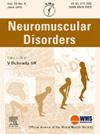Clinical and genetic characteristics based on the Japanese patient registry for facioscapulohumeral muscular dystrophy: a nationwide analysis
IF 2.7
4区 医学
Q2 CLINICAL NEUROLOGY
引用次数: 0
Abstract
The Japanese patient registry for facioscapulohumeral muscular dystrophy (FSHD) was launched in September 2020, enrolling patients genetically confirmed to have FSHD. This study aimed to analyze clinical and genetic characteristics based on data from the Japanese FSHD registry. Core items were collected from the TREAT-NMD FSHD dataset, version 1.0. By the end of June 2024, over 200 patients were enrolled, with 161 successfully registered after confirmation. Among them, 156 had FSHD1 and 5 had FSHD2; 81 had affected family members; 116 were ambulatory; 73 had respiratory dysfunction; 22 required mechanical ventilation; 8 had cardiac dysfunction; 4 had retinopathy; and 22 had hearing loss. In patients with FSHD1, the median number of D4Z4 repeats was four, with a low proportion of long repeats. D4Z4 repeat counts influenced age at disease onset, site-specific muscle weakness onset, respiratory function, retinopathy, and hearing loss. Notably, female patients were more likely to have early facial weakness and hearing loss. Our data suggest population diversity in D4Z4 repeat numbers and sex differences. We aim to collaborate with patient groups to enroll more participants and gather more accurate epidemiological data, including cases of FSHD2. Additionally, we plan to investigate racial differences through international collaboration.
基于日本面部肩胛骨-肱骨肌萎缩症患者登记的临床和遗传特征:一项全国性的分析
日本面部肩胛骨肱肌营养不良症(FSHD)患者登记处于2020年9月启动,招募了基因证实患有FSHD的患者。本研究旨在根据日本FSHD登记处的数据分析临床和遗传特征。核心项目收集自TREAT-NMD FSHD数据集1.0版本。截至2024年6月底,入组患者200余例,经确认注册成功161例。其中FSHD1 156例,FSHD2 5例;家庭成员受影响81例;116例为流动患者;73例有呼吸功能障碍;22台需机械通气;心功能障碍8例;视网膜病变4例;22人有听力损失。在FSHD1患者中,D4Z4重复序列的中位数为4个,长重复序列的比例较低。D4Z4重复计数影响发病年龄、部位特异性肌无力发病、呼吸功能、视网膜病变和听力损失。值得注意的是,女性患者更容易出现早期面部无力和听力丧失。我们的数据表明D4Z4重复数的种群多样性和性别差异。我们的目标是与患者团体合作,招募更多的参与者,并收集更准确的流行病学数据,包括FSHD2病例。此外,我们计划通过国际合作来调查种族差异。
本文章由计算机程序翻译,如有差异,请以英文原文为准。
求助全文
约1分钟内获得全文
求助全文
来源期刊

Neuromuscular Disorders
医学-临床神经学
CiteScore
4.60
自引率
3.60%
发文量
543
审稿时长
53 days
期刊介绍:
This international, multidisciplinary journal covers all aspects of neuromuscular disorders in childhood and adult life (including the muscular dystrophies, spinal muscular atrophies, hereditary neuropathies, congenital myopathies, myasthenias, myotonic syndromes, metabolic myopathies and inflammatory myopathies).
The Editors welcome original articles from all areas of the field:
• Clinical aspects, such as new clinical entities, case studies of interest, treatment, management and rehabilitation (including biomechanics, orthotic design and surgery).
• Basic scientific studies of relevance to the clinical syndromes, including advances in the fields of molecular biology and genetics.
• Studies of animal models relevant to the human diseases.
The journal is aimed at a wide range of clinicians, pathologists, associated paramedical professionals and clinical and basic scientists with an interest in the study of neuromuscular disorders.
 求助内容:
求助内容: 应助结果提醒方式:
应助结果提醒方式:


